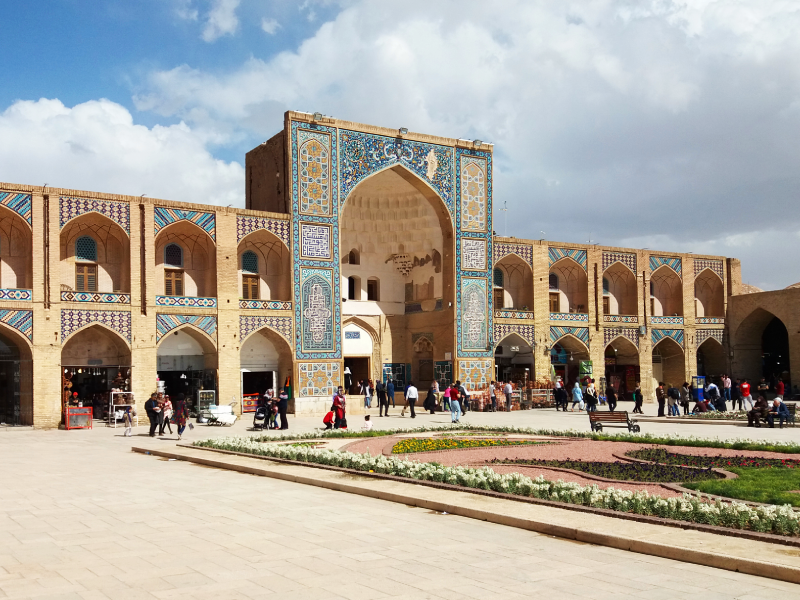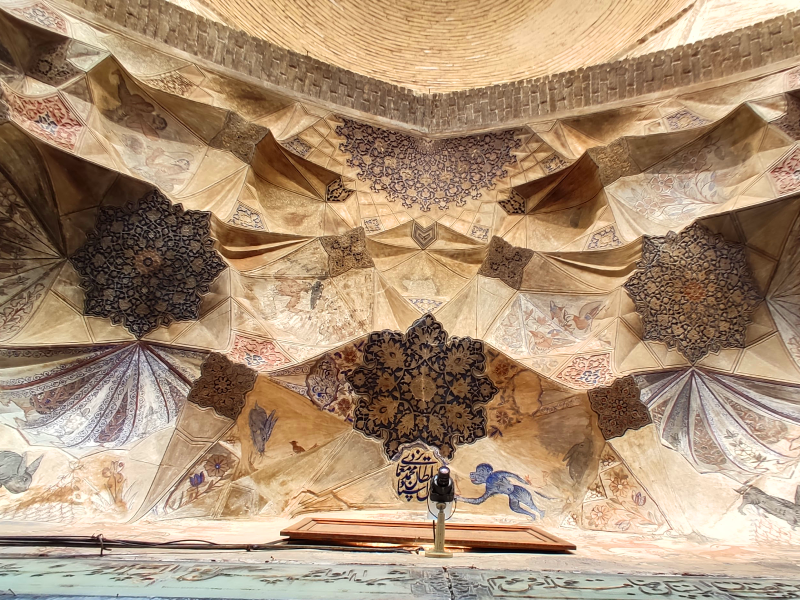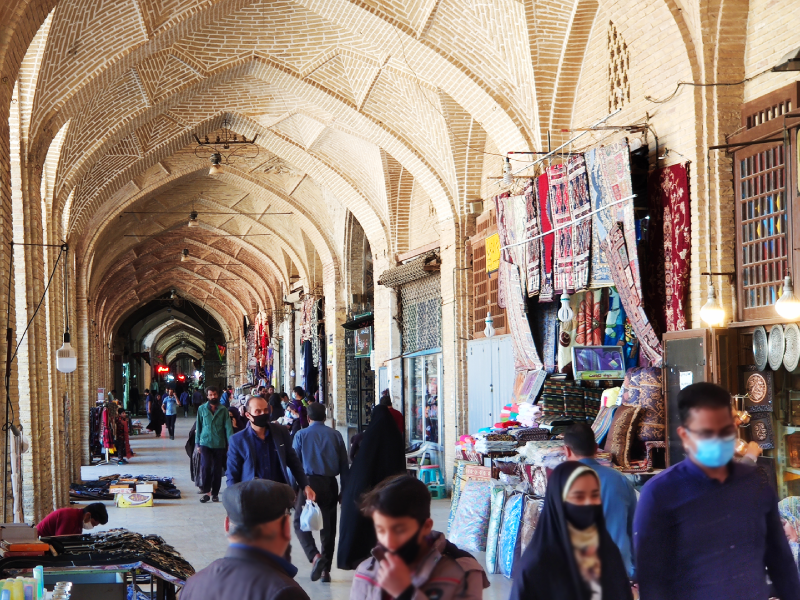Grand Bazaar of Kerman (Photos, History, Architecture)
A traditional bazaar established more than 600 years ago in the cultural city of Kerman, the historical Kerman Grand Bazaar is one of the national works of Iran and one of the top sightseeing locations of Kerman Province. The Kerman bazaar was built and redeveloped by several Persian rulers; thus, this place holds the unique specialty of each period. Some of the earmarks of the Grand Bazaar of Kerman have made this traditional location stand out among the best Iran bazaars and the world.
The Grand Bazaar of Kerman is a perfect place to purchase traditional souvenirs and tour inside the middle-eastern halls of the bazaar.
About The Grand Bazaar of Kerman
One of the largest provinces of Iran is Kerman, which is located in the heart of the desert in the southeast of the country. The province has seven thousand historical attractions, and 700 works are included in the list of national monuments in Iran. Because of the existence of a large number of attractions in Kerman, this province has been named the fifth historical city of Iran.
The Grand Bazaar of Kerman, also known as Ganjali Khan Bazaar, was inscribed as a national heritage work on 25 May 2001. The bazaar has been active throughout many historical periods. Its architectural style is rich and valuable, with sacred geometry principles used in every corner of the structure. The Grand Bazaar of Kerman is seen as the largest and longest market in Iran and has been the hub for trade, export, and import of the province for a long time.
Because the bazaar complex was built on the Silk Road (a network of Eurasian trade routes active from the second century BCE until the mid-15th century), it played a big role in the economic growth of Kerman. Clothes, copper utensils, and all kinds of handicrafts made in Kerman were exported to China and India. In contrast, spices and clothes from abroad were imported into this bazaar.
Ganjali Khan Bazaar
Kerman Grand Bazaar includes different halls and markets. Interestingly, the buildings connected inside the bazaar make up 60% of Kerman’s historical monuments. In each of these markets, you will find several buildings, such as mosques and old bathhouses.
Walking around the Kerman Bazaar Complex and visiting the antique shops glowing in a multitude of colors, from spices and sweets to carpets and traditional utensils, will entice you. The Mesgari market, where the copper utensils are crafted, reflects a long history and common tradition in the Bazaar of Kerman, while the Mozaffari market offers the locals their daily purchases.
The bazaar not only provides high-quality goods and souvenirs for purchase, it also serves as an archeological site. For instance, the tallest windmill located inside the bazaar is a very popular attraction.
The Grand Bazaar of Kerman History
During the reign of Shah Abbas of the Safavid Period, Ganjali Khan ruled the city of Kerman for 30 years. This brought forth many historical buildings seen in Kerman built by his order. For this reason, the Grand Bazaar of Kerman is also called Ganjali Khan Bazaar.
The traditional bazaar of Kerman, along with the entire Ganjali Khan complex, is about 11,000 square meters, and the whole complex was built by a famous Kerman architect named Mohammad Yazdi. The architect was originally from Isfahan, which is why the architectural style of Kerman Bazaar is constructed in the style of Isfahani buildings.
In the beginning, the bazaar was not very large, and gradually, the businesses expanded in the markets, and the retailers of the bazaar decided to expand the markets in line with the formation of the city. Because of this, the Grand Bazaar of Kerman starts right from Arg Square and leads to Mushtaqiye Square.
In the past, the Ganjali Khan complex, along with its bazaar, were separated from each other, but with the expansion of the city, these complexes were eventually connected together.
The Grand Bazaar of Kerman Architecture
The structure of Kerman’s traditional market is made up of elements or sections, including the Sera, which is the main and secondary streets or crossings, Timcheh meaning an area in the bazaar with a domed ceiling and a pond in the center surrounded by shops, and Chaharsuq meaning intersection.
Sera, or the main and secondary streets, is a long route in the market, where on both sides, various stores and shops are found, each offering distinguished goods.
When you step into the bazaar, you come across a central courtyard surrounded by traditional stores. If you take a look at the Grand Bazaar of Kerman photos, you will see that in the Grand Bazaar are halls with ceilings dedicated to the exchange of special goods.
These halls and spaces are known as Timcheh and are decorated with unique Persian ornamentations. The Chaharsuq, or the intersection of the two main streets of the market, also boasts a stunning atmosphere bearing the Iranian architecture, which will put you in awe.
The main aspect of The Grand Bazaar of Kerman’s architecture is viewed in its simplicity. The characteristics of its architecture are the repeating formations of the arches in large and small dimensions with regular shapes and symmetry, decorated with blue tiles in some areas.
Oil paintings can still be seen in parts of the ceiling of the bazaar. The exterior part of the bazaar does not have sophisticated works, except for structures such as old Persian wind turbines, mosques, and caravanserais, which also bear a symbolic appearance.
Before the construction of the main building fabric of the bazaar, the row of domes was like the spinal column of the city from the top view. The bazaar was in harmony with the colors of the desert, and only minarets and windmills were spotted from a distance.
In addition to being a covered space inside the Grand Bazaar, the traditional shops of Kerman are built in a condensed fashion to have the most shaded area and the least absorption of the sun’s blazing desert heat.
The outside layer on the outer body of the structure acts as an insulator and reflects the radiant heat. The ceiling of the Grand Bazaar is very high, which causes a pleasant airflow inside the halls and Timcheh. Also, the vents of the vaults help with air conditioning and light supply. In some buildings, wind deflectors have been used for air conditioning.
Grand Bazaar of Kerman Opening Hours
The historic Kerman Bazaar complex is open every day from 9:00 AM to 9:30 PM., except on Fridays and public holidays.
Available Amenities in the Kerman Bazaar
- Washrooms
- Residence
- Restaurants
- Access to the Internet
Final Word
Kerman, like any other big city in Iran, has a traditional Grand Bazaar located in the heart of the city and is one of the busiest parts of the city. The architectural elements used in the Grand Bazaar of Kerman make it unique worldwide. Kerman market is the longest market in Iran! It seems like it never ends!
From sweets and local breads to organic and natural products such as vegetables and pistachios, you can find anything in the Kerman Bazaar Complex. This place is very historical, and its lively atmosphere is worth visiting. In addition, don’t forget to buy Kerman handicrafts such as traditional shoes and carpets, and above all, Kerman’s famous cumin.
No matter how much we describe the magnificence and beauty and details of the amazing architecture of this market, it is still not enough unless you explore Kerman Grand Bazaar yourself. What has made this bazaar in Iran world famous is that despite the passage of time, it still has maintained its old structure.
Are you planning to travel to Iran & look for an Iran travel agency? Check out our Iran tours. Here’s a free Kerman Virtual Tour for you!









Leave a Reply
Want to join the discussion?Feel free to contribute!